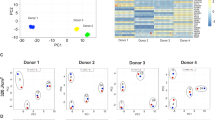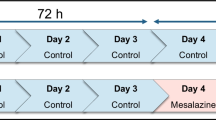Abstract
Recent study revealed that photodynamic therapy (PDT) with a novel photosensitizer (ATX-S10(Na)) shows more potent effects for various skin diseases than ALA-PDT. The effect of ATX-S10(Na)-PDT on dermal fibroblasts is still unknown. Using dermal fibroblasts derived from normal and scleroderma patients, and mouse skin in vivo, we compared the effects of ATX-S10(Na)-PDT and ALA-PDT. Fibroblasts from normal, scleroderma patients or mice skin were treated with ATX-S10(Na)-PDT or ALA-PDT. After the PDT treatments, the expression of matrix metalloproteinases (MMPs) Tissue inhibitors of metalloproteinases (TIMPs) and collagen synthesis was assayed using ELISA and reverse transcription-PCR (RT-PCR). The expression of MMP-1 and MMP-3 was slightly decreased and collagen I mRNA was significantly increased in scleroderma fibroblasts compared with normal fibroblasts. Both ATX-S10(Na)-PDT and ALA-PDT increased the expression of MMP-1 and MMP-3 in protein and mRNA levels in both normal and scleroderma fibroblasts with more potent effect by ATX-S10(N)-PDT. Collagen I synthesis was markedly decreased by ATX-S10(Na)-PDT and by ALA-PDT again with more potent effect by ATX-S10(Na)-PDT in both normal and scleroderma fibroblasts. In mice skin the effect of PDT for MMPs and collagen I was also detected and the effect was more potent in ATX-S10(Na)-PDT. In contrast, MMP-2, TIMP-1, TIMP-2, and collagen III expression was not affected by the ATX-S10(Na)-PDT or ALA-PDT treatment. ATX-S10(Na)-PDT is more potent modulator for dermal matrix components than ALA-PDT and might be useful for scleroderma patients.





Similar content being viewed by others
Abbreviations
- 5-ALA:
-
5-Aminolevulinic acid
- MMP:
-
Matrix metalloproteinase
- PDT:
-
Photodynamic therapy
- RT-PCR:
-
Reverse transcription-PCR
- TIMP:
-
Tissue inhibitors of metalloproteinase
References
Berg K (1996) Mechanism of cell damage in photodynamic therapy. In: Honigsmann H, Jori G, Young AR (eds) The fundamental bases of phototherapy. OEMF Spa, Milano, pp 181–207
Brenneisen P, Wenk J, Klotz O, Wlaschek M, Brivibal K, Krieg T, Sies H, Scharffetter-Kochanek K (1998) Central role of ferrous/ferric iron in the ultraviolet B irradiation-mediated signaling leading to increased interstitial collagenase (matrix-degrading metalloproteinase (MMP)-1 and stromelysis-1(MMP-3) mRNA levels in cultured human dermal fibroblasts. J Biol Chem 273:5279–5287
Fritsch C, Goerz G, Ruzicka T (1998) Photodynamic therapy in dermatology. Arch Dermatol 134:207–214
Hawk A, English FC (1997) Localized and systemic scleroderma. Semin Cutan Med Surg 20:27–37
Herrmann G, Wlaschek M, Lange TS, Prenzel K, Goerz G, Scharffetter-Kochanek K (1993) UVA irradiation stimulates the synthesis of various matrix-metalloproteinases (MMP) in cultured human fibroblasts. Exp Dermatol 2:92–97
Karrer S, Abels C, Landthaler M, Szeimier RM (2000) Topical photodynamic therapy for localized scleroderma. Acta Derm Venereol (Stockh) 80:26–27
Karrer S, Bosserhoff AK, Weiderer P, Landthaler M, Szeimier RM (2003) Influence of 5-aminolevulinic acid and red light on collagen metabolism of human dermal fibroblasts. J Invest Dermatol 120:325–331
Karrer S, Bosserhoff AK, Weidere P, Landthaler M, Szeimirs RM (2004) Keratinocyte-derived cytokines after photodynamic therapy and their paracrine induction of metalloproteinases in fibroblasts. Br J Dermatol 151:776–783
Kennedy JP, Pottier RH, Pross DC (1990) Photodynamic therapy with endogenous protoporphyrin IX: basic principles and present clinical experience. J Photochem Photobiol B 6:143–148
Kuhari VM, Sandberg M, Kalimo H, Vuorio T, Vuorio E (1988) Identification of fibroblasts responsible for increased collagen production in localized scleroderma by in situ hybridization. J Invest Dermatol 90:664–670
Kurwa HA, Barlow RJ (1999) The role of photodynamic therapy in dermatology. Clin Exp Dermatol 24:143–148
Maniatis T, Fritsch EH, Sambrook T (1989) Molecular cloning: a laboratory manual, 2nd edn. Cold Spring Harbor Laboratory, New York
Morison WL (1997) Psoralen UVA therapy for linear and generalized morphea. J Am Acad Dermatol 37:675–679
Morton CA, Brown SB, Collins S, Ibbotson S, Jenkinson H, Kurwa H, Langmack K, McKenna K, Moseley H, Pearse AD, Stringer M, Taylor DK, Wong G, Rhodes LE (2002) Guideline of topical photodynamic therapy: report of a workshop of the British photodermatology group. Br J Dermatol 146:552–567
Nakajima S, Sakata I, Takemura T (1992) Tumor localizing and photosensitization of photo-chlorin ATX-S10(Na). In: Spinelli P, dal Fante M, Marchesini R (eds) Photodynamic therapy and biological lasers. Elsevier, Amsterdam, pp 531–534
Nakajima S, Sakata I, Hirano T, Takeyama T (1998) Therapeutic effect of interstitial photodynamic therapy using ATX-S10(Na) and a diode laser on radio-resistant SCC II tumors of C3H/He mice. Anticancer Drugs 9:539–543
Ormrod D, Javis B (2000) Topical aminolevulinic acid HCl photodynamic therapy. Am J Dermatol 1:552–557
Petersen MJ, Hansen C, Craig S (1992) Ultraviolet A irradiation stimulates collagenase production in cultured human fibroblasts. J Invest Dermatol 99:440–444
Petersen MJ, Hansen C, Craig S (1993) Ultraviolet A irradiation stimulates collagenase production in cultured human fibroblasts. J Invest Dermatol 99:440–444
Raza SL, Cornelius LA (2000) Matrix metalloproteinases: pro- and anti-angiogenic activities. J Invest Dermatol Symp Proc 5:47–54
Tajiri H, Yokoyama K, Boku N, Ohtsu A, Fujii T, Yoshida S, Sato T, Hakamata K, Hayashi K, Sakata I (1997) Fluorescent diagnosis of experimental gastric cancer using a tumor-localizing photosensitizer. Cancer Lett 111:215–220
Takahashi H, Kinouchi M, Tamura T, Iizuka H (1996) Decreased β2-adrenergic receptor-mRNA and loricrin-mRNA, and increased involucrin-mRNA transcripts in psoriatic epidermis: analysis by reverse transcription-polymerase chain reaction. Br J Dermatol 134:1065–1069
Takahashi H, Manabe A, Ishida-Yamamoto A, Hashimoto Y, Iizuka H (2002) Aberrant expression of apoptosis-related molecules in psoriatic epidermis. J Dermatol Sci 28:187–197
Takahashi H, Itoh Y, Nakajima S, Sakata I, Iizuka H (2004) ATX-S10(Na) photodynamic therapy for human skin tumors and benign hyperproliferative skin. Photodermatol Photoimmunol Photomed 20:257–265
Takahashi H, Nakajima S, Sakata I, Ishida-Yamamoto A, Iizuka H (2005) Photodynamic therapy using a novel photosesitizer, ATX-S10(Na): comparative effect with 5-aminolevulinic acid on squamous cell carcinoma cell line, SSC15, ultraviolet B-induced skin tumors, and phorbol ester-induced hyperproliferative skin. Arch Dermato Res 296:496–502
Takahashi H, Nakajima S, Sakata I, Ishida-Yamamoto A, Iizuka H (2005) ATX-S10(Na)-photodynamic therapy is less carcinogenic for mouse skin compared with ultraviolet B irradiation. Br J Dermatol 153:1182–1186
Author information
Authors and Affiliations
Corresponding author
Rights and permissions
About this article
Cite this article
Takahashi, H., Komatsu, S., Ibe, M. et al. ATX-S10(Na)-PDT shows more potent effect on collagen metabolism of human normal and scleroderma dermal fibroblasts than ALA-PDT. Arch Dermatol Res 298, 257–263 (2006). https://doi.org/10.1007/s00403-006-0689-6
Received:
Revised:
Accepted:
Published:
Issue Date:
DOI: https://doi.org/10.1007/s00403-006-0689-6




